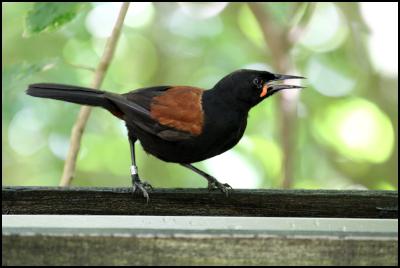Birds fly in to new Hauraki Gulf island reserve
Birds fly in to new Hauraki Gulf island reserve

Forty tīeke
(saddleback) and 40 pōpokotea (whitehead) are being flown
from Hauturu o Toi (Little Barrier) to Rotoroa Island today
– the first wildlife species to be introduced to this
unique new wildlife reserve in the making.
The bird translocations follow extensive planting, monitoring and pest eradication on Rotoroa, and mark the start of an ambitious 25-year plan by Auckland Zoo and the Rotoroa Island Trust (RIT) that includes introducing up to 20 new species by 2018.
Kiwi, Duvaucel’s gecko and moko skink are among other wildlife planned for release later this year.
“Together with our RIT partners, we’re taking a very new approach to creating a wildlife reserve. We’re aiming to help secure New Zealand’s unique biodiversity in a way that’s a deliberate departure from what’s been done before,” says Auckland Zoo director, Jonathan Wilcken.
“We will be introducing species at a greatly accelerated rate and including wildlife that wouldn’t necessarily have been found on Rotoroa Island before. In doing so, we aim to create a diverse and novel ecosystem, and one which will allow us to showcase the sort of interventionist approach to conserving wildlife that New Zealand is increasingly becoming known for around the world.
“By demonstrating how intensive management of wildlife can help with their conservation, we will provide the community - from school students to island visitors - opportunities to play an active role in the ongoing health and management of the island. It’s an inclusive vision of conservation success that focuses on how people and wildlife can benefit each other. We hope to help foster a whole new generation of conservationists,” says Mr Wilcken.
Rotoroa Island Trust chairman Barrie Brown says the arrival of the birds is a major milestone in the development of Rotoroa.
“It’s the first step in introducing a range of native species to the island and we hope it will be the beginning of a very special conservation experience for those who come to visit,” says Mr Brown.
The tīeke and pōpokotea are being released into the northeast of the island where there is good established forest habitat. Over 500 nest and roost boxes for the tīeke (attached to trees by bungy cords) have been built by Long Bay College students to provide these birds with plenty of roosting and nesting site choices and to cater for future breeding.
Ngati Manuhiri, the kaitiaki (guardians) of all the toanga on Hauturu o Toi are supportive of this bird translocation, and will be accompanying the tīeke and pōpokotea to their release site on Rotoroa.
FAST
FACTS: Rotoroa Island Wildlife Reserve
• The Rotoroa Island Trust (RIT) and Auckland Zoo formed a partnership in 2012 to create a wildlife reserve on Rotoroa, funded by the Hutton Wilson Charitable Trust ($4m over five years)
• For 100 years, Rotoroa was run by the Salvation Army as a drug and alcohol rehabilitation centre, and was closed to the public, a role that ceased in 2005. www.rotoroa.org.nz
• In 2011, Rotoroa reopened to the public as an arts, heritage and conservation centre park, after the Hutton Wilson Charitable Trust purchased a 100-year lease of Rotoroa from the Salvation Army, who still own the island.
• Since 2008, 20,000 exotic trees have been removed and over 350,000 New Zealand native plants have been reintroduced
• Along with today’s arrival of tīeke (saddleback) and pōpokotea (whitehead), a solar-powered sound system to broadcast calls at a newly established artificial gannet colony on the island (designed to attract a real colony) will be switched on. Gannets are especially valuable to terrestrial ecology; through their guano (poo) they introduce many valuable nutrients that benefit the whole ecosystem
• The Rotoroa Wildlife Management and Translocation Plan 2013-2038 and the Rotoroa Current State Assessment can be found at: http://www.aucklandzoo.co.nz/conservation/rotoroa-island.aspx
• Hauturu o Toi (Little Barrier) is of high cultural significance for Ngati Manuhiri, with the reserve transferred to the hapu in 2013 as part of their Treaty Settlement. The island was then gifted back to the people of New Zealand, with a 1.2ha site being retained by Ngati Manuhiri as part of their cultural redress. Ngati Manuhiri support research and management programmes that deliver outcomes that complement their cultural values and aspirations.
ENDS


 Gordon Campbell: DeepSeek, And China’s Inexorable Rise
Gordon Campbell: DeepSeek, And China’s Inexorable Rise Te Pāti Māori: Our Tamariki Deserve Better Than Seymour's Slop
Te Pāti Māori: Our Tamariki Deserve Better Than Seymour's Slop Barnardos: Barnardos Aotearoa Welcomes Minister’s Support For 0800 What’s Up Helpline
Barnardos: Barnardos Aotearoa Welcomes Minister’s Support For 0800 What’s Up Helpline  PSA: Minister Must Reverse All Oranga Tamariki Cuts After Barnardos U-turn
PSA: Minister Must Reverse All Oranga Tamariki Cuts After Barnardos U-turn Department Of Internal Affairs: Public Service AI Framework - Guiding Responsible Deployment Of Artificial Intelligence
Department Of Internal Affairs: Public Service AI Framework - Guiding Responsible Deployment Of Artificial Intelligence Fire and Emergency NZ: Celebrate Without Fireworks This Lunar New Year
Fire and Emergency NZ: Celebrate Without Fireworks This Lunar New Year NZ Labour Party: Luxon Misleading On The Economy
NZ Labour Party: Luxon Misleading On The Economy


